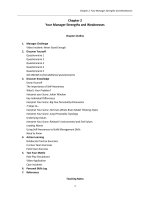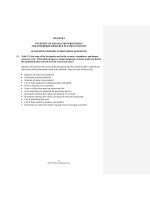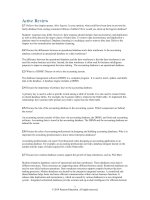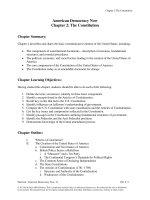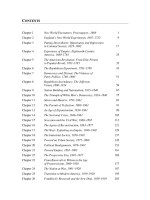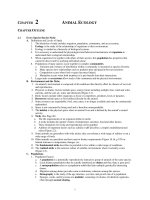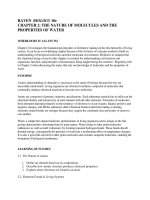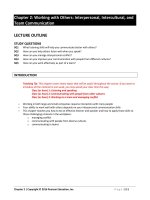Test bank and solution of buesinss communications (1)
Bạn đang xem bản rút gọn của tài liệu. Xem và tải ngay bản đầy đủ của tài liệu tại đây (974.23 KB, 34 trang )
Chapter 2: Working with Others: Interpersonal, Intercultural, and
Team Communication
LECTURE OUTLINE
STUDY QUESTIONS
SQ1
SQ2
SQ3
SQ4
SQ5
What listening skills will help you communicate better with others?
How can you help others listen well when you speak?
How can you manage interpersonal conflict?
How can you improve your communication with people from different cultures?
How can you work effectively as part of a team?
INTRODUCTION
Teaching Tip: This chapter covers many topics that will be useful throughout the course. If you want to
introduce all the material in one week, you may spend your class time this way:
Class (or hour) 1: Listening and speaking
Class (or hour) 2: Communicating with people from other cultures
Class (or hour) 3: Working as a team and managing conflict
Working in both large and small companies requires interaction with many people
Your ability to work well with others depends on your interpersonal communication skills
This chapter teaches you how to be an effective listener and speaker and how to apply those skills to
three challenging contexts in the workplace:
o managing conflict
o communicating with people from diverse cultures
o communicating in teams
Chapter 2 | Copyright © 2016 Pearson Education, Inc.
P a g e | 2-1
STUDY QUESTION 1 What listening skills will help you communicate better with
others?
Teaching Tip: To help students become better listeners, spend a few minutes each week on listening
exercises, like those provided in the IM.
Social Media in Action: Social media gives companies new ways to listen to customers, understand
their feelings about the company, and identify issues. But listening on the Internet is also a challenge
because there is so much noise in the social media world and so many places where customers’ voices
may be heard. Nestor Portillo of Microsoft talks about how his company developed an integrated
listening strategy to “harvest data from different sources to analyze conversations to see which are the
top issues and what are the early warning signals.” (Listening in the Social Media Era,
Portillo’s insights provide a way to start a discussion about what listening
means in a social media era.
Listening is the most frequently used communication skill for new employees in the workplace
Research shows that people typically listen at only 25% efficiency
Listening is a key component of emotional intelligence, the ability to perceive and understand
emotions and to use that knowledge as a guide to behavior
Passive listening is hearing what someone says without actively paying attention to ensure
understanding
Active listening is a process of focusing attentively on what a speaker says, actively working to
understand and interpret the content, and then responding to acknowledge understanding. FIGURE
2.1 illustrates active listening. Four types of active listening skills are:
o hearing accurately
o comprehending and interpreting
o evaluating
o responding
Active listening is especially important in synchronous communication, where all parties are present
at the same time:
o face-to-face conversations
o telephone conversations
o meetings
Discussion Starter: What barriers to listening have you experienced in the workplace or in the
classroom? How have you overcome them?
Hearing accurately (see Key Concept Exercise 1)
Some barriers to hearing are physiological; for example, the speed at which your brain can process
what you hear
Some barriers are environmental; for example, a noisy office or work area
The key to hearing accurately is focus
Discussion Starter: In what ways has texting become a barrier to hearing and listening?
Chapter 2 | Copyright © 2016 Pearson Education, Inc.
P a g e | 2-2
Comprehending and interpreting (see Key Concept Exercises 2, 3, and 4)
Comprehension – how well you understand what you hear or read
Interpretation – analyzing the meaning of what you hear, read, or see to determine its intention
“Listen” to nonverbal communication
o Nonverbal communication – messages conveyed through means other than words; for
example, emphasis and tone of voice, facial expressions, gestures, posture, body language,
and behavior
o FIGURE 2.2 illustrates that nonverbal signals can have multiple meanings
Ask questions and paraphrase to ensure understanding
o Paraphrasing – restating someone’s point in different words
o FIGURE 2.3 shows that you can paraphrase for content, intent, and feeling
Be aware of gender-specific communication styles
o Men and women often develop different gender-related styles of communication
o Men tend to interrupt more than women do, and women tend to minimize their assertiveness
by using hedges, hesitations, and tag questions
o Recognizing gendered characteristics of your own and others’ language helps avoid incorrect
conclusions and communication breakdowns
Supplemental Homework: See the end of this IM chapter for the assignment titled Analyzing Nonverbal
Communication.
Supplemental Homework: See the end of this IM chapter for supplemental homework assignment
titled Observing Gender-Specific Communication Styles.
CULTURE: Facial Expressions Are Not Universal
(See Collaboration Exercise 29)
People from Eastern cultures tend to focus on a person’s eyes when reading facial expressions, while
people from Western cultures tend to focus on a person’s entire face
Emoticons, used to represent facial expressions in email, reflect these cultural differences (see visual)
Why is it important to be aware of cultural differences in perception of body language in business
communication?
Evaluating (see Key Concept Exercise 5)
Evaluating – the practice of critically reviewing and judging communication
Making good business decisions depends on your ability to evaluate what you hear
Evaluating fairly requires being open-minded and separating emotions from logic
Discussion Starter: How is evaluating what you hear in a face-to-face conversation different from
evaluating what you read in a written document?
Responding (see Key Concept Exercise 6)
Responding has two roles in the listening process: letting the speaker know you understand the point
and initiating the next step in the conversation
Responses can be verbal and nonverbal
FIGURE 2.4 outlines five different ways to respond to a speaker
Chapter 2 | Copyright © 2016 Pearson Education, Inc.
P a g e | 2-3
STUDY QUESTION 2 How can you help others listen well when you speak?
Teaching Tip: When you ask students to do speaking exercises like the in-class activities in this chapter,
try modeling the activity first with one of the class members (or have two students model it in front of
the room). This will help students visualize what they are supposed to be doing in the exercise.
Supplemental Homework: Pick any one of the six speaking strategies identified in this chapter and
consciously practice using it during the week. For example, if you have a negative criticism, frame it
positively. Write a paragraph (200 words or so) to submit to your instructor, identifying what you did
and what you learned about yourself as a speaker.
Listeners and speakers are partners in the communication process
This section covers six general speaking strategies
Focus on your audience (see Key Concept Exercise 7)
Before speaking, analyze your audience by considering their interests, potential listening barriers,
questions or objections they may have, and the best way to connect with them
In-class Activity: With a partner in class, have a two-minute conversation about “the most interesting
thing you read or learned last week.” For the first minute, one partner focuses on his or her topic and
consciously focuses on the other person (the audience), trying to connect with the audience and involve
him or her in the conversation. Then switch sides. Share what you learned with the class.
Share the conversation (see Key Concept Exercise 8)
A good interpersonal communicator will avoid monologues and instead invite the audience to respond
or add to the conversation
In-class Activity: With a different partner, repeat the in-class activity listed under “focus on your
audience.” However, this time, share the conversation for two minutes. When it’s your turn, speak only
one or two sentences, beginning by connecting to what the other person has said. Share what you
learned with the class.
Use clear, concrete, unambiguous language (see Key Concept Exercise 9)
Ambiguous language may mean different things to different people
Pay particular attention to pronouns, replacing them with nouns when necessary
In-class Activity: To help students understand the difference between abstract and concrete language,
ask students to take out a piece of paper and sketch what they visualize when they hear these terms:
farm animal, power tool, dessert, accessory, etc. Ask students to share their sketches and talk about
how they visualized that abstract term. Discuss the differences. Then, for any one term, ask students to
think of a context in which it is better to use the more abstract term, and a context in which it is better
to use a more concrete term.
Support your message with good nonverbal communication (see Key Concept Exercise 10)
As a speaker, you can use nonverbal communication in three ways to enhance your communication:
o Use body language and eye contact to engage your audience
o Use a strong and positive tone of voice
o Use gestures and facial expressions that complement your message
Chapter 2 | Copyright © 2016 Pearson Education, Inc.
P a g e | 2-4
Discussion Starter: When you communicate by phone, you can’t use body language or facial
expressions to help convey your message. What other methods could you use to enhance your
meaning?
Teaching Activity: Start with a simple statement like “Please come in and shut the door” or “Help Jane
complete the project.” Speak the statement three times, varying its meaning by changing your tone of
voice, emphasis, facial expression, and body language. Ask students to determine the meaning of each
statement—and to discuss why they reached each conclusion.
Avoid language that triggers a negative response (see Key Concept Exercise 11)
Four specific types of language that can cause a negative response are:
o Biased language suggests prejudice, prejudgment, or disrespect
o Provocative questions are designed to annoy and inflame
o Accusatory language focuses negative attention on the person rather than on the issue
o Trigger words and phrases elicit immediate negative emotional responses
Frame negative comments positively (see Key Concept Exercise 12)
Take care in how you phrase constructive criticism to a coworker or employee
Start out positively
Chapter 2 | Copyright © 2016 Pearson Education, Inc.
P a g e | 2-5
STUDY QUESTION 3 How can you manage interpersonal conflict?
Teaching Tip: If there are any current conflicts at your school, in your local community, or in national
politics, ask students to read a bit about the conflict and spend time in class facilitating a discussion
about the cause of the conflict. Have the students suggest management techniques that might be
effective.
Conflict is one of the most significant and costly problems in a workplace, but not all workplace conflict
is bad
Cognitive conflict results in differences in understanding content and tasks; working through such
conflict often leads to better decisions and work products
Affective conflict results in differences in personalities and relationships; if unaddressed, it can lead to
tension, stress, and dysfunctional work processes
Conflict management is a more helpful term than conflict resolution because it recognizes that some
conflicts cannot be resolved
Identify the cause of the conflict (see Key Concept Exercise 13)
FIGURE 2.5 illustrates the causes of cognitive and affective conflicts
Competing goals
o Successful businesses work toward a number of goals that sometimes compete with each
other
Differences of opinion
o Best resolved by a rational decision-making process, which may involve compromise
Faulty assumptions
o People often draw conclusions or make decisions based on faulty assumptions
o Avoid this conflict by sharing information with each other
Relational issues
o Relational and personality conflicts can stand in the way of productivity and are costly to
businesses
o Explore ways to resolve such conflicts, seeking help from managers if necessary
Ego issues
o Threaten someone’s sense of professional identity or self-image
Discussion Starter: If it’s true that “we like those most who are most like us,” should managers strive to
keep the members of a group similar to avoid conflict?
Teaching Activity: Invite a speaker from your campus counseling service to discuss or role play the
types of conflicts commonly experienced, and suggest how to manage those conflicts.
Select an appropriate management technique (see Key Concept Exercise 14)
FIGURE 2.6 illustrates five different techniques for managing conflicts
Avoid confrontation
o Sometimes avoidance is a good choice; for example, if you believe there is no chance of
resolving the conflict and it does not interfere with production
o Most often, avoiding conflict makes it worse
Accommodate or give in
o Accommodating is a wise choice when:
you decide that your position was wrong
Chapter 2 | Copyright © 2016 Pearson Education, Inc.
P a g e | 2-6
the conflict is trivial and you don’t care about the result
you are negotiating; sacrifice something less important to gain something you want
more
you believe that maintaining a good relationship with the other person is more
important than the outcome of the issue
o Accommodating is dangerous if it means sacrificing your principles and beliefs
o Groupthink is a process by which a group reaches a decision by eliminating all critical thinking
that threatens consensus
Compete to win
o May result in quick solutions
o Needs a third party with authority to decide the issue
o Often leads to relational conflicts, especially when the following tactics are used:
rejecting others’ points of view
finding fault
assigning blame
Compromise
o Offers a quick resolution to the issue
o Allows parties with competing goals or differences of opinion to be partially satisfied
o May fail to adequately resolve the conflict or achieve the ultimate goal
Collaborate to find the best solution
o Requires that all parties work together to determine the best possible solution
o Time-consuming
o When possible, this is the best approach for managing complex conflicts when time is not at
issue
Discussion Starter: When involved in an affective conflict, why is it important to address emotional
issues before addressing issues about the content of work? What are potential consequences if you
don’t?
Teaching Activity: Invite a guest speaker from a local labor union or an HR representative who works
with union negotiations to speak to the class about negotiation techniques. How do people resolve
business differences?
Chapter 2 | Copyright © 2016 Pearson Education, Inc.
P a g e | 2-7
STUDY QUESTION 4 How can you improve your communication with people from
different cultures?
Teaching Tip: Depending on where you teach, you may have students in your class who have experience
with other cultures based on where they have lived, where they have traveled, or what their own ethnic
background is. Offer opportunities for these students to provide insights and tell stories that can help
others in the class.
Culture – the learned and shared attitudes, values, and behaviors that characterize a group of people
Prepare to communicate with people from other cultures by understanding the key ways that cultures
differ and by developing strategies that help you communicate with diverse groups
Understand how cultures differ (see Key Concept Exercise 15)
Ethnocentrism – an inappropriate belief that your culture is superior to all others
Stereotypes – oversimplified images or generalizations of a group
High context versus low context
o Context – a term that refers to how people in a culture deliver, receive, and interpret
messages
o Countries exist on a continuum from high context to low context (see FIGURE 2.7)
o Low-context cultures rely on explicit language to communicate
o High-context cultures derive meaning not just from words but from everything surrounding the
words
Individualism versus collectivism
o Key dimension of culture identified by Dutch intercultural expert Geert Hofstede
o Individualist culture – values an individual’s achievement, satisfaction, and independent
thinking
o Collectivist culture – puts the good of the group or organization before people’s individual
interests
Power distance
o Power distance – a characteristic of cultures that describes how the culture perceives
inequality and authority
o In cultures with high power distance, organizations are formal and have a clear separation
between superiors and subordinates
o In cultures with low power distance, organizations are more relaxed about title and status
Uncertainty avoidance
o Uncertainty avoidance – a measure of how comfortable a culture is with ambiguity, risk, and
change
o In cultures that are uncomfortable with uncertainty and ambiguity, employees tend to like
clear guidelines that lead to predictable results
o In cultures that are comfortable with uncertainty and ambiguity, employees tend to like
flexible working environments that allow for risk-taking and entrepreneurial behavior
Time orientation
o Monochronic culture – values punctuality and efficiency
o Polychronic culture – has a relaxed attitude toward time and punctuality
o Understanding the different approaches to time is crucial to maintaining smooth cross-cultural
relationships
Chapter 2 | Copyright © 2016 Pearson Education, Inc.
P a g e | 2-8
Teaching Activity: Assign students to research your campus’s study abroad program, or invite someone from
the program to class to discuss international opportunities and offer information to broaden students’ multicultural experiences.
Develop strategies that help you communicate with diverse groups (see Key Concept Exercise 16)
FIGURE 2.8 presents verbal and nonverbal strategies
Nonverbal strategies
o Do:
pay attention to the other person’s nonverbal communication
mirror it when appropriate
smile
o Don’t:
ignore or discount details of how people maintain eye contact, shake hands, or stand
when talking
presume that an unsmiling face will be taken more seriously
Verbal strategies
o Do:
be clear and concise
listen carefully
request feedback to ensure understanding
o Don’t:
use idioms, expressions that mean something other than the literal meaning of its
words
use jargon, the specialized language of a specific field
get distracted by differences in accent and dialect
assume that smiles and nods mean that what you are saying has been understood
Both
o Do:
be polite, courteous, and respectful
o Don’t:
assume that decorous behavior means someone is being impersonal or distant
attempt humor
Discussion Starter: How might social media help you to learn about communicating with people from
different cultures?
ETHICS: Apple Faces Ethical Challenges Abroad
(See Key Concept Exercise 17)
Serious problems arise when U.S.-based companies work with foreign partners that engage in activities
considered unethical in the United States
Apple suffered a damaged reputation when the manufacturing facilities that it contracted with in
China were found to have unsafe working conditions. Explosions in two iPad factories killed 4 people
and injured 77.
Apple made a commitment to monitor the plants more closely; however, safety violations continued.
Ultimately, Apple engaged an intermediary—the independent Fair Labor Association—to inspect
plants and interview workers.
Chapter 2 | Copyright © 2016 Pearson Education, Inc.
P a g e | 2-9
Was Apple responsible for the working conditions and abuse at its overseas facilities? Or were its local
contractors responsible? Should Apple have been more diligent from the start?
Chapter 2 | Copyright © 2016 Pearson Education, Inc.
P a g e | 2-10
STUDY QUESTION 5 How can you work effectively as part of a team?
Teaching Tip: Provide opportunities in the class for students to work as a team and to reflect on that
experience. Reflection is an important tool to help students learn from their experiences.
Discussion Starter: If you experience group conflict but need to meet a pressing deadline, which should
you prioritize: resolving the conflict or meeting the deadline? Why?
In workplace environments, your work with others will often be accomplished in teams
To be effective, a team involves two or more people who recognize and share a commitment to a
specific, common goal and who collaborate in their efforts to achieve that goal
Assemble an effective team (see Key Concept Exercise 18)
To assemble strong team members, consider the following questions and strategies:
o How big should my team be?
Create teams of three to five people, which are typically more productive than larger
teams
Appoint an odd number of people
Break into subteams to complete parts of a project
o What are the skills needed to complete this team project effectively?
Identify the work that needs to be done and the skills necessary for doing it
o Who has the time and resources to contribute effectively to the team project?
Ask colleagues with area expertise to join the team or to recommend a substitute
o Who may be the most interested in this topic (and therefore motivated to participate)?
Consider prior experience and professional development
o Who is easy to work with?
Consider interpersonal skills as well as project-specific skills
In-class Activity: See the end of this IM chapter for the in-class activity entitled Identifying Team Talent.
Agree on team goals and standards (see Key Concept Exercise 19)
Good teams are goal-oriented
Good teams are results-oriented
o Team members have a clear role and are held accountable for their contributions
o Workload is divided equitably
o The team has a timely, effective communication system
o Team members give each other prompt and helpful feedback on their performance
Good teams have standards and hold each team member accountable for them
Discussion Starter: You’ve been assigned to a team of four individuals tasked with completing a
detailed recommendation report to submit to your company’s executive committee. You have two
weeks to conduct the research, analyze the data and information, and write the report, in addition to
completing your regular responsibilities. Why is it important for your team to take time to establish
goals and standards? What are the potential consequences if you don’t establish them?
Pay attention to team development and dynamics (see Key Concept Exercise 20)
FIGURE 2.9 illustrates a model for understanding team development proposed by Bruce Tuckerman
What happens at each stage?
o Forming – team members get to know each other
Chapter 2 | Copyright © 2016 Pearson Education, Inc.
P a g e | 2-11
o Storming – teams experience conflict and begin to confront differences
o Norming – team members learn how to manage conflict and work with each other efficiently
o Performing – team members work collaboratively and achieve a high level of productivity
An alternative to Tuckerman’s model, by Amy Edmondson, emphasizes teaming: the process of
bringing people together for a short period to solve a specific problem
Teaming requires frequent communication to learn collectively, fix issues quickly, and put the best
ideas into action. Recommendations include:
o ask for help and clarification early and often
o share information quickly and broadly
o discuss mistakes
o try out new strategies and ideas
o continuously seek out feedback to improve ideas and processes
In-class Activity: Ask students to work in small groups to list examples of team conflicts (without
identifying names). What caused the problems? How, if at all, did the team resolve them?
Develop good leadership practices (see Key Concept Exercise 21)
A leader is not in charge of a team but rather in service of a team
A leader can serve a team in the following ways:
o Establish and maintain a vision of the future
o Create a supportive climate
o Delegate responsibility and assign tasks equitably
o Establish a timeline, using scheduling tools such as Gantt charts (FIGURE 2.10)
o Keep the project on track
o Manage meetings effectively and encourage positive collaboration
o Ensure effective decision making
o Resolve differences
Plan for effective meetings (see Key Concept Exercise 22)
Create an agenda
o Agenda – a detailed plan or outline of the items to be discussed at a meeting
o FIGURE 2.11 illustrates a sample agenda
Distribute the agenda sufficiently in advance
Assign someone to serve as a timekeeper during the meeting
Assign someone to serve as a note taker during the meeting
o Meeting minutes – notes that describe what was discussed at a meeting, what was decided,
and what actions will follow
o FIGURE 2.12 also shows sample minutes of a team meeting
Plan for follow-up
Discussion Starter: What are the consequences of not using an agenda for a meeting (or distributing a
poorly written agenda)?
Discussion Starter: What strategies could you use to ensure that synchronous online meetings with
attendees from different regions or countries are run smoothly? What are potential barriers or
problems that might arise and how could you overcome them?
Be a good team member (see Key Concept Exercise 23)
Make a commitment to the team and its goals
Create a collaborative working environment
Chapter 2 | Copyright © 2016 Pearson Education, Inc.
P a g e | 2-12
Support and encourage your teammates
Support team decisions
Focus on continuous quality improvement
TECHNOLOGY: Using Social Media to Collaborate
(See Writing Exercises 25 and 26)
Why do companies use social media and collaboration tools?
To enhance communication and teamwork within the organization
How do companies use social media and collaboration tools?
File sharing and real-time collaborative writing
Brainstorming and getting feedback on ideas
Sharing knowledge
IN SUMMARY,
The interpersonal skills you learned in this chapter span basic listening and speaking skills to the more
complex skills of emotional intelligence, managing conflict, working with people from other cultures,
and working well in teams
Throughout this course, you will apply these skills both in the classroom and within team projects
Teaching Tip: The end-of-chapter Case Scenario, Working as a Cross-Cultural Team, p. 60, will help
students apply the material in this chapter.
Chapter 2 | Copyright © 2016 Pearson Education, Inc.
P a g e | 2-13
CONVERSATIONS @ WORK: ESPN Radio
This advice from hosts of a popular sports talk show illustrates how challenging it can be to listen and ask
questions well. The prompts encourage students to reflect on their own awareness of conversational
dynamics. (SQ1; SQ2; AACSB Tags: Written and Oral Communication; Interpersonal Relations and Teamwork;
Reflective Thinking)
DISCUSSION QUESTION 1: What examples have you witnessed of people talking over each other? Of
people talking and waiting to talk? What suggestions do the hosts give for dealing with these
problems?
Possible answers: Answers will vary based on experience, but thoughtful responses will include the
students’ own past mistakes. Both hosts emphasize the importance of listening, and recommend
shorter, open-ended questions, as well as flexibility and openness to changes in direction.
DISCUSSION QUESTION 2: How important is it to put someone at ease in a conversation? What are the
best ways to do so in the kinds of conversations you have most frequently?
Possible answers: Students should come up with their own detailed and specific reasons why it is
important to help people lower their guard. Both hosts emphasize the importance of engagement.
Humor is one way to put people at ease.
Supplementary Reflection Exercise
What evidence would you offer for your own skills as a listener? Who are your role models for both
effective speaking and attentive listening?
Possible answers: Answers will vary based on experience, but thoughtful answers will include specific
details.
Chapter 2 | Copyright © 2016 Pearson Education, Inc.
P a g e | 2-14
CASE SCENARIO: Working as a Cross-Cultural Team
This case study includes six questions. If evaluating for points, consider attributing points to each element of
the answer as well as the students’ writing style and grammar/mechanics.
QUESTION 1: What interpersonal, intercultural, and teamwork communication issues are emerging in this
scenario? (SQ3; SQ4; SQ5; AACSB Tags: Written and Oral Communication; Diverse and Multicultural Work
Environments; Interpersonal Relations and Teamwork)
SAMPLE ANSWERS:
Interpersonal issues
The resistance to schedule early/late times could have created a negative interpersonal situation.
Maansi’s silence could be interpreted negatively. By listening to nonverbal communication, the team
could have improved their interpersonal communication.
Intercultural
Before the meeting began, both teams could have researched each other’s cultures to better prepare
for differences in context, individualism/collectivism, power distance, etc.
Teamwork communication
The New Delhi interns’ focus on programming should be investigated. Were they asked to participate
because of their technology skills? What is their role on the team?
Both teams could have paraphrased each other’s comments to promote understanding.
Both teams should have requested feedback to ensure understanding.
QUESTION 2: Listening involves a number of specific skills: hearing, comprehending and interpreting,
evaluating and responding. Which of these areas contributed to the communication problem in this
scenario? Identify specific examples. (SQ1; AACSB Tags: Written and Oral Communication; Diverse and
Multicultural Work Environments; Interpersonal Relations and Teamwork)
SAMPLE ANSWERS: All of these areas contributed to the communication problem in this scenario:
Hearing: No one asked Anant to repeat what he said, leaving most of what he said unknown.
Comprehending: When the computer programming issues were presented, the Nashville team should have
asked the New Delhi team to explain why those issues were important to the project.
Interpreting: Both teams should have analyzed the different frames of reference to try to better understand
each other’s perspective of the project.
Evaluating: There was no subsequent group evaluation of the initial meeting and the Nashville and New Delhi
team seemed to have different agendas and understandings of the project.
Responding: Both teams should have requested feedback to ensure understanding.
Chapter 2 | Copyright © 2016 Pearson Education, Inc.
P a g e | 2-15
QUESTION 3: How would you describe the difference between the two approaches? Which approach would
help Roberto accept the criticism? (SQ2; AACSB Tag: Interpersonal Relations and Teamwork)
SAMPLE ANSWERS:
Option #1 may trigger a negative response and frames the situation in a negative manner. However, Option #2
focuses on Roberto and uses positive language and outcomes.
The second approach would help Roberto accept the criticism and promote an effective collaboration (e.g.,
Roberto has great ideas, you both want strong evaluations, you want to enjoy working together).
QUESTION 4: Besides accommodating, what specific actions could you take to manage the conflict with
Maansi and Anant if you decided to avoid, compete, compromise, or collaborate? Which approach do you
believe would lead to the best outcome? (SQ3; AACSB Tag: Interpersonal Relations and Teamwork)
SAMPLE ANSWERS:
Specific actions to manage the conflict include:
Avoid confrontation: You could go ahead with your own agenda and, when complete, send it to Anant and
Maansi to program in an online format. This might result in an effective combined project, but the content
would reflect only the internship experiences in Nashville, not New Delhi.
Compete to win: You suggest that the New Delhi team work separately and then compare your products at the
end of the summer to determine which should be submitted. However, neither project would reflect the needs
of both locations.
Compromise: You could suggest that your team draft the content and send it to the New Delhi team mid-way
through the time line. The New Delhi interns could then add their own content and focus on the programming
aspects of the website. The final week of the project could be devoted to evaluating and revising the final
handbook before it is submitted.
Collaborate: As the best approach, both teams would collaborate on both the content and the website design
interface. Leadership roles would be divided between the two locations, but all four team members would
participate in all aspects of the project to ensure an effective result.
Collaboration is the best approach because it ensures a product that reflects the internship experiences at
both locations.
QUESTION 5: What factors may explain the cultural differences between the U.S. and Indian team
members? (SQ4; AACSB Tag: Diverse and Multicultural Work Environments)
NOTE: Answers should identify the difference in context and the presentation of ideas and materials, as well as
the uncertainty avoidance with respect to workload and priorities.
Chapter 2 | Copyright © 2016 Pearson Education, Inc.
P a g e | 2-16
QUESTION 6: Study Question 5 describes some of the characteristics that successful teams share. This team
ultimately was successful. How did it demonstrate these characteristics? (SQ5; AACSB Tag: Interpersonal
Relations and Teamwork)
SAMPLE ANSWERS:
Worked through communication issues by utilizing email correspondence and clear meeting agendas
Compromised schedules to overcome the time differences and priorities
Tried to read nonverbal cues during phone conversations
Requested feedback to ensure understanding
Chapter 2 | Copyright © 2016 Pearson Education, Inc.
P a g e | 2-17
REVIEW QUESTIONS
1. Name two barriers that interfere with hearing. Possible answers include: differences in mental processing
speed between speaking and hearing; inattention due to multitasking; temporary hearing loss; noise and
other environmental distractions; and other barriers that decrease the listener’s focus. (SQ1; AACSB Tag:
Written and Oral Communication)
2. How does comprehension differ from interpretation? Comprehension is how well someone understands
what he or she hears. Interpretation is more complex, and involves analyzing the meaning of a
communication. (SQ1; AACSB Tag: Written and Oral Communication)
3. What are three types of paraphrasing? Paraphrasing consists of restating the literal content, the ultimate
intention, or the emotional content of what you have heard. (SQ1; AACSB Tags: Written and Oral
Communication; Interpersonal Relations and Teamwork)
4. Describe how a person “listens” to nonverbal communication. One “listens” to nonverbal communication
by paying attention to facial expressions, body language, posture, gestures, and behavior. (SQ1; AACSB
Tags: Written and Oral Communication; Interpersonal Relations and Teamwork)
5. What is the difference between a provocative question and an authentic question? Authentic questions
are used to ask for information, share opinions, and provide confirmation. Provocative questions are used
to attack, shame, or blame the target. (SQ2; AACSB Tags: Written and Oral Communication; Interpersonal
Relations and Teamwork)
6. Under what circumstances is it a good idea to accommodate (or give in) during a conflict? Possible
answers include: if you decide that you are wrong and have changed your mind; if the conflict is trivial or
one in which you don’t care about the results; or if maintaining a harmonious relationship with the other
person is more important than the outcome. (SQ3; AACSB Tag: Interpersonal Relations and Teamwork)
7. What is ethnocentrism? It is the belief that your own culture is superior to others. (SQ4; AACSB Tag:
Diverse and Multicultural Work Environments)
8. Name one way that an individualistic culture differs from a collectivist culture. Possible answers include:
valuing individual achievement, satisfaction, and independent thinking; considering one’s own
achievement to be more important than obligation and loyalty to a group; prioritizing individual incentives;
rewarding individual leaders for a company’s success. (SQ4; AACSB Tag: Diverse and Multicultural Work
Environments)
9. What are the four stages of team formation? The four stages are forming, storming, norming, and
performing. (SQ5; AACSB Tag: Interpersonal Relations and Teamwork)
10. Describe two ways that file-sharing tools such as Google Docs help teams collaborate. Possible answers
include: automatic versioning to track changes in documents; real-time distributed authorship and review
of documents; availability of resources from multiple locations and devices; rapid access to updated
materials. (SQ5; AACSB Tags: Written and Oral Communication; Information Technology)
CRITICAL THINKING QUESTIONS
Each critical thinking question includes multiple questions or justification to support responses. The set of 10
questions could be assigned as a comprehensive assignment, or sets of questions could be identified to
support specific aspects of students’ learning.
1. Some research suggests that emotional intelligence is a stronger predictor of job success than
traditional intelligence—how smart you are. Why do you think emotional intelligence is so
important for many jobs? (SQ1; AACSB Tags: Written and Oral Communication; Interpersonal
Relations and Teamwork)
Chapter 2 | Copyright © 2016 Pearson Education, Inc.
P a g e | 2-18
NOTES: Students’ answers will vary, but could include the following components of emotional
intelligence and their application to a wide range of job-related situations: (1) recognizing one’s own
emotions; (2) interpreting tone, facial, expressions, and body language; (3) tracking behavior and
comparing it with the language used; and (4) paraphrasing to draw out the emotional as well as the
literal content of a statement.
2. Explain a situation—either at home, school, or work—in which you listened passively and neglected
to hear important information. Describe the negative result and identify how you could have used
active listening strategies to improve your communication process. (SQ1; AACSB Tags: Written and
Oral Communication; Interpersonal Relations and Teamwork)
NOTES: Students’ answers will vary based on their personal experiences. They should identify how
they would use the active listening skills of hearing, comprehending and interpreting, evaluating, and
responding.
3. Designers of consumer products argue that to understand what customers really need, you have to
do more than listen to what they say. You have to observe what they do. Why do you think there is
often a gap between what people say and what they do? (SQ1; AACSB Tag: Written and Oral
Communication)
NOTES: What students think may vary. Possible answers: (1) emphasis or tone of voice indicate how
people feel about a product as opposed to what they think of it; and (2) while they may be verbalizing
what they think is “correct”, their body language will be more indicative of their opinions.
4. Review the speaking strategies listed at the beginning of SQ2. Divide them into two lists: strategies
that you currently try to use when you speak and strategies that you typically do not think about. Of
the strategies that you typically do not think about, identify one that you’d like to begin using
immediately and explain why. (SQ2; AACSB Tag: Written and Oral Communication)
NOTES: Students’ answers will vary based on their personal experiences. They should identify two lists
of strategies: (1) those they currently use, and (2) those they don’t think about. Then they should
identify one strategy from the second list and describe why they would like to begin using it.
5. What words or phrases trigger a negative emotional response from you? If someone repeatedly uses
one of your “trigger words,” what are your options for responding? Which option would you
choose? (SQ2; AACSB Tags: Written and Oral Communication)
NOTES: Students’ answers will vary. They should include the following information: (1) trigger
words/phrases, (2) their options for responding to these word/phrases, and (3) which option they
would choose.
6. Some organizations provide the services of mediators to help resolve workplace conflicts. What are
the advantages of having a disinterested party resolve a conflict? What are the advantages of having
people involved in the conflict work it out on their own? (SQ3; AACSB Tag: Interpersonal Relations
and Teamwork)
NOTES: Answers should address two parts: (1) the advantages of using a mediator (e.g., the mediators’
impartially to focus on both parties’ needs, mediate differences of opinion, avoid competing goals,
Chapter 2 | Copyright © 2016 Pearson Education, Inc.
P a g e | 2-19
work through relational differences, and identify ego issues); and (2) the advantages of having people
involved in conflict work it out on their own (e.g., taking ownership for the solution, collaborating to
reach a balanced compromise, and better understanding each other’s perspectives).
7. Imagine you have been hired by a global company that is holding a two-week orientation for all new
employees at the head office in San Francisco. You will be staying in a hotel for two weeks, and you
have been assigned to share a room with a new employee from Zurich, Switzerland. What can you
do to find out in advance a little bit about the culture in Zurich? Once you have identified some
characteristics of that culture, what can you do to ensure that you do not stereotype your
roommate? (SQ4; Diverse and Multicultural Work Environments)
SAMPLE ANSWER: You can research the culture in Switzerland by using web-based search tools to find
credible sources. Before stereotyping, you can observe your roommate’s interaction and analyze
his/her communication. If you think the roommate is open to the discussion, you could share your
findings and ask for feedback about the validity of the information.
8. Explain a team situation in which you experienced conflict. What was the purpose of the team? Why
did the affective and/or cognitive conflict to occur? How did the team resolve the conflict? What
was the impact on the final product? (SQ3, SQ5; AACSB Tag: Interpersonal Relations and Teamwork)
NOTES: Students’ answers will vary based on their personal experiences. They should identify four
parts in their answer: (1) the purpose of the team, (2) why the conflict occurred (and whether it was
affective or cognitive), (3) how the team resolved the conflict, and (4) the impact of the conflict on the
final product.
9. Imagine you have a teammate who wants to do all the project work himself because he does not
trust anyone else on the team to produce high-quality results. How would you respond to that
teammate? (SQ5; AACSB Tag: Interpersonal Relations and Teamwork)
SAMPLE ANSWER: You could analyze the situation by asking why he doesn’t want to share the
responsibility for complete the work with the entire team. If his motivation is earning the best grade
possible, you could explain that collaboration would allow more work to be done and a variety of
perspectives to be included. If he seems to be motivated by ego, identify that everyone has different
skills, and the team could learn from each other while completing the project.
10. Social loafing refers to the tendency of certain people to do less work when they are part of a team
than they would when working independently. What strategies can a team use to minimize social
loafing of team members? (SQ5; AACSB Tag: Interpersonal Relations and Teamwork)
SAMPLE ANSWER: The team can develop more explicit goals and standards, and share them in writing.
If goals and standards (especially expectations for engagement and effort) are spelled out, it becomes
harder for individuals to rationalize doing less than they are capable of. The team can also take care to
define what results are expected from each individual when dividing work or assessing team progress.
Chapter 2 | Copyright © 2016 Pearson Education, Inc.
P a g e | 2-20
KEY CONCEPT EXERCISES
SQ1 What listening skills will help you communicate better with others?
1 Hearing accurately (AACSB Tags: Written and Oral Communication; Diverse and Multicultural Work
Environments)
NOTES: Students will identify strategies to improve listening in two situations.
SAMPLE ANSWERS:
a. Four strategies the team could take to make it easier for a teammate who has a hearing impairment:
1. Use written agendas and meeting notes that are prepared ahead of time to share information
2. Emphasize nonverbal communication to support spoken meaning
3. Ensure speakers face the hearing-impaired teammate and speak loudly/clearly
4. Ask a teammate seated next to the hearing-impaired teammate to summarize/paraphrase
5. Record comprehensive minutes that are distributed quickly
Four things the hearing-impaired teammate can do to better hear the team:
1. Paraphrase teammate’s information to ensure understanding
2. Ask teammates who mumble to speak up
3. Copy teammate’s meeting notes
4. Record the meeting to play back later (or use voice recognition software)
b. To ensure your mind doesn’t wander during meetings, you could: focus on the speaker and
concentrate on the content, take good notes, be engaged in the conversation (e.g., ask questions), and
ask questions to help the speaker get to the point.
2 Comprehending and interpreting—listening to tone of voice (AACSB Tag: Written and Oral
Communication)
NOTES: Students will (a) identify different meanings communicated through different nonverbal cues and (b)
determine whether paraphrased statements reflect content, intent, or feeling.
SAMPLE ANSWERS:
a. “I didn’t do anything wrong” suggests that the speaker isn’t at fault for the wrong action.
“I didn’t do anything wrong” suggests that the speaker’s actions were not wrong.
b. “We need to talk now” implies a specific group of people who need to talk.
“We need to talk now” implies that the conversation is urgent.
c. “I’ll give you my phone number after the meeting” emphasizes what will be given.
“I’ll give you my phone number after the meeting” emphasizes when it will be given.
d. “When did you come up with this idea?” focuses on when the idea was conceived.
“When did you come up with this idea?” focuses on who conceived the idea.
“When did you come up with this idea?” focuses on which idea was conceived.
Chapter 2 | Copyright © 2016 Pearson Education, Inc.
P a g e | 2-21
3 Comprehending and interpreting—paraphrasing to ensure understanding (AACSB Tag: Written
and Oral Communication)
SAMPLE ANSWERS:
a. Accounts payable / Purchasing
So you are saying that our computer system will not allow you to pay a partial invoice?
Content – states the understanding of the explicit message
So, it’s company policy not to pay partial invoices?
Intent – uncovers why accounts payable made the statement
You sound like you might want some help with the invoices since you’re spending…
Feelings – determines the emotions in the statement
b. Interviewer / Interviewee
Your goal has always been to go into public relations?
Intent – uncovers why accounts payable made the statement
So, you were frustrated and that led to a career change?
Feelings – determines the emotions in the statement
You believe that public relations will make better use of your talents.
Content – states the understanding of the explicit message
4 Comprehending and interpreting—being aware of gender-specific communication styles (AACSB
Tags: Written and Oral Communication; Diverse and Multicultural Work Environments)
NOTES: Students will discuss scenarios (either in teams or the whole class) that describe gender-specific
communication styles. They will identify (1) whether they have noticed these types of differences in their own
experience and (2) what they would recommend the participants do to bridge the differences. Samples
answers for the second half of the exercise are provided.
SAMPLE ANSWERS:
a. Establish that gender and/or personality differences exist, identify that both perspectives have merit,
and determine if they have a shared understanding of the goals for the project before moving forward.
b. Appreciate each other’s points of reference, but also share the need to feel comfortable with the
wording to ensure understanding. Both Richard and Alice can agree to avoid metaphors and anecdotes
and use concrete, specific wording.
c. Denise needs to understand that males tend to interrupt when they have a point and that she also
needs to interrupt to ensure her point of view gets equal time. However, James needs to understand
that women don’t often feel comfortable interrupting someone else. If James interrupts, he needs to
pause to allow Denise to speak, too.
Chapter 2 | Copyright © 2016 Pearson Education, Inc.
P a g e | 2-22
5 Evaluating (AACSB Tags: Written and Oral Communication; Interpersonal Relations and Teamwork)
NOTES: Students will describe how they would evaluate a colleague’s proposal to require that new hires have
three years of work experience.
SAMPLE ANSWERS: (1) Remove prejudice of Bob’s negative attitude (e.g., “Bob is always complaining about
something and offers nothing but negative comments at meetings”), (2) remove prejudice about your own
background and situation (e.g., “You have made friends with one of the new hires, and … You were hired right
out of college, too”), (3) avoid jumping to conclusions based on your own experience, (4) keep an open mind
when critically evaluating the idea, and (5) separate emotions from logic.
6 Responding (AACSB Tags: Written and Oral Communication; Interpersonal Relations and
Teamwork)
NOTES: Students will compose responses to a teammate who misses deadlines and completes partial work but
says she will meet the next deadline. Six different responses will be identified, as well as the best one. Students
should be prepared to discuss their answers in class.
SAMPLE ANSWERS:
a. Ask a question:
b. Make a judgment:
c. Contribute an opinion:
d. Give advice:
e. Argue or disagree:
f. Express empathy:
Is there anything I can do to help you meet this deadline?
You have all the information you need. I’m sure you’ll do well.
I don’t think you’ll make the deadline; let’s discuss alternatives.
If you finish your work the night before, you’ll have time to proofread, too.
I don’t think you have enough time. Let’s reassess our timeline.
I know you’ve been very busy lately. Let me know if I can help.
SQ2 How can you help others listen well when you speak?
7 Focus on your audience (AACSB Tag: Written and Oral Communication)
NOTES: Answers will vary based on student experience. Students are to assume a friend/relative called to ask
how school or work is going. Students will write a two-paragraph email to the instructor. The first paragraph
will identify the friend/relative and the intent of the call. The second paragraph will explain how they would
respond and why, as well as what they wouldn’t include and why.
8 Share the conversation (AACSB Tag: Written and Oral Communication)
NOTES: Answers will vary based on students’ observations of meeting or meal conversations in small groups.
Responses to four questions are required. No specific format is implied. Students can be instructed to write
their answers, prepare a presentation, or discuss their responses in small groups.
Chapter 2 | Copyright © 2016 Pearson Education, Inc.
P a g e | 2-23
9 Use clear, concrete, unambiguous language (AACSB Tag: Written and Oral Communication)
SAMPLE ANSWERS:
a. You did a great job on that report.
Do I normally not do a great job?
Possible revision: You did a great job on that report, as usual.
b. Mary’s job performance hasn’t been satisfactory this year.
What about Mary’s performance has been poor?
Possible revision: Mary has missed all of our deadlines this year.
c. Our presentation needs to be perfect.
Why? What about our presentation needs to be perfect?
Possible revision: Our presentation will determine if the client chooses our plan. We need to make
sure we predict all possible objections.
d. There are just a few small problems to clear up before signing the contract.
What are the small problems?
Possible revision: Before signing the contract, we need to change the starting date from the 1st to the
3rd, reduce the costs by 2%, and change the deadline to the end of the year.
e. Clean up the conference room before the end of the day.
Why do I have to clean up the conference room? By myself? When is the end of the day?
Possible revision: Make sure janitorial services cleans up the conference room before 5 PM.
f.
Let’s talk after the project is finished.
What do we need to talk about? When will the project be finished?
Possible revision: Let’s talk about changes in staffing assignments after the project is finished next
week.
10 Support your message with good nonverbal communication (AACSB Tag: Written and Oral
Communication)
NOTES: Answers will vary based on student experience. Students’ will ask a stranger for directions and observe
the person’s nonverbal communication. Responses are required for three questions: (1) the person’s verbal
message, (2) the nonverbal elements that support the message, and (3) any nonverbal elements that conflict
with the message.
Chapter 2 | Copyright © 2016 Pearson Education, Inc.
P a g e | 2-24
11 Avoid language that triggers a negative response (AACSB Tags: Written and Oral Communication;
Diverse and Multicultural Work Environments)
NOTES: Answers will vary based on students’ perceptions of themselves. Students will react to labels someone
could use to identify them and select the term(s) they prefer. For the remaining labels, students are to explain
the problems with the terms and any bias they may represent.
SAMPLE ANSWERS:
Young lady/Young man – diminutive and dismissive
Woman/Man – ambiguous
Gal/Guy – informal and unprofessional
Expert – may be misleading or tough to live up to
Consultant – may be appropriate
Genius – misleading and may make employees defensive
College girl/College boy – diminutive, dismissive, and inaccurate
12 Frame negative comments positively (AACSB Tag: Written and Oral Communication)
NOTES: Students will respond to three scenarios by providing criticism without using “but.”
SAMPLE ANSWERS:
a. Although I appreciate that you were thinking about how the handouts could easily be distributed at
one time, I want to provide each sheet individually throughout the session so we can focus on one
aspect of the training at a time. Please remove the staples and separate the sheets. Thanks.
b. I think employee morale would improve if people knew that they were doing a good job. Your positive
reinforcement would be very well received.
c. As much as I enjoy the information you share about colleagues, your supervisor could view it as a lack
of confidentiality. Maybe if you demonstrate that you can keep sensitive information from spreading,
you will be trusted with more responsibility.
SQ3 How can you manage interpersonal conflict?
13 Identify the cause of the conflict (AACSB Tag: Interpersonal Relations and Teamwork)
NOTES: Students will evaluate three scenarios to determine the cause of conflict (e.g., competing goals,
differences of opinion, lack of information, relational issues, or ego issues).
SAMPLE ANSWERS:
a. Competing goals or difference of opinion about the criteria for the selection
b. Difference of opinion about the professionalism of the logo options
c. Difference of opinion about the importance of the deadline versus the seriousness of the errors
Chapter 2 | Copyright © 2016 Pearson Education, Inc.
P a g e | 2-25
